Projector on the knee
It happens to me that you wake up in the middle of the night and think: “I wonder, till the morning for a long time? Need to try to fall asleep or does it make no sense already? ” At this point, look at the clock, but:
In this regard, I had a long-standing idea to buy projection clocks, which are being projected onto the ceiling, but with them, too, everything is not so simple, because, first, they need to be bought. Especially for them, you won't go to the store, but you can't buy it “at the same time” - you forget. Secondly, it is necessary that they “shine” into the ceiling constantly, because pressing a button is not that lazy, but putting the clock near the sleeping place so that it is convenient to press a button will not work. With the "constant light" the same problem - I did not find the clock shining all at once out of the box, but the collective farm itself "to hold the button forever and solder the external power supply" was not very interesting.
And it so happened that my Huawei P1 phone broke, so it stopped being a telephone, but everything else in it, in general, worked. It will not be possible to sell, but it is a pity to throw it out, and the brain inflamed by such a contradiction began to look for a place for the application of a semi-working device.
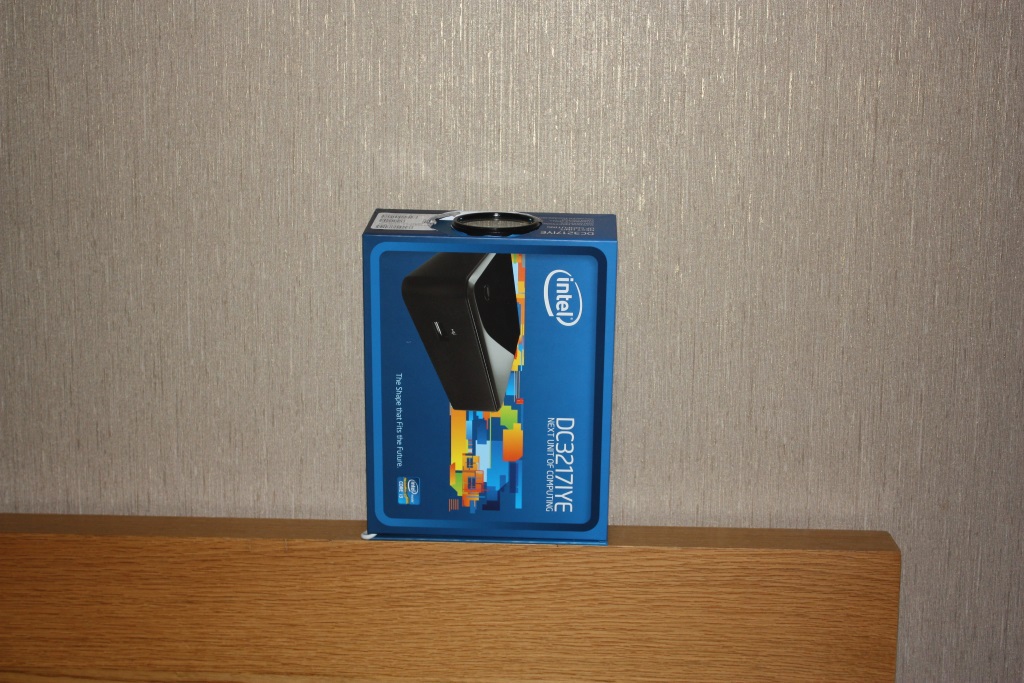
What happened next - under the cut.
The school experiment with the camera obscura seems to be imprinted forever in the mind. I always wanted to do it myself, but somehow my hands did not reach. And then there were very favorable circumstances for the creation of the device, the design is very similar, and in effect the opposite is true - the projector. Residual school-university knowledge in optics was enough to figure out that to create a masterpiece, you need, in general, only three things: the "radiating matrix", the focusing lens and the body. As the first one, the P1 could well have acted; it was not impossible to make a case out of a box of shoes, and to find an office magnifying glass for 50 rubles in a nearby stationery store did not look like a changer either. After that, it was necessary to bring some watches to P1, project them to the ceiling, and, with a fuzz, the problem with nighttime confusion was solved.
')
The raid in the stationery shop ended with the purchase of a 75mm magnifying glass, the rustling of the bins of the homeland - the capture of an Intel NUC box in the cabinet. There must be a digression about why it is the box from under the NUC. There are two reasons for this. First: it is made of very good cardboard - thick and beautiful. Second: it is designed so that the inside is inserted from the end into the outside. Such a device promised tremendous advantages in experiments with focusing - the “matrix” could be fixed on the inside of the box, the lens on the outside and quite fit to move one relative to the other, achieving focus. So the box from under the NUC supported the focusing mechanism out of the box, for shoe boxes would have had to collectively special things.
The first attempt to collect all this together, as usual, failed. It turned out that the clerical magnifying glass is an extremely long-focus thing. Therefore, in order for the image to be focused, it was necessary either to between the lens and the screen (read the ceiling, because IT had to project the image on the ceiling) was five meters, and I do not live in the Hermitage, I have 3 meters to the ceiling , or so that between the "matrix" and the lens was about 60 cm, which did not fit into my idea of the correct dimensions of the projector. Convulsive searches led to a lens in a DYI instrument called the “third hand,” like the one that was immediately sacrificed by extracting that same lens. It gave a much better result - the distance between the P1 and the lens was about 20 cm, the distance between the lens and the ceiling was about 2 m, which was suitable for mounting the device either on the table or on the headboard. However, as it turned out, this lens is of rather mediocre quality - with wild distortion and focal length, smoothly changing from the center of the lens to the edges. So it was possible to achieve that either the center of the image was in focus, or the edges, which of course did not suit me. Muti in the image was enough because of myopia, I did not want it to be generated also by the projector. Thoughts about the lens from the camera rushed convulsively in the head (they were discarded immediately, because the device, which was originally conceived as cost-free, was no longer as such due to the purchase of a clerical lens. Adding a lens to the system made it quite expensive at all) (from friends they were, and it was possible to pick up for free, but friends were far away, but the action was like here and now). And then I remembered that I have a set of macrolins for the camera, extremely useless for a photo (I played 15 minutes when I bought it and did not use it anymore) and were cheap enough (4 pieces for 10 bucks) so as not to ruin it. Bought a long time, but here it looks one to one. A lens labeled + 10x fit perfectly. It kept a distance of 20 cm between the lens and the “matrix”, under which I had cut out the seats for the “matrix” in the box and gave a very sharp image over the entire frame area.
As a result, I have a device that from the head of the bed projects the image from the phone to the ceiling.
The diagonal of the image is about 1.5 meters. It is enough to consider the numbers, having myopia of almost any degree. True, there is one snag. As with any projector, the image from the matrix is inverted with a lens. Therefore, in order for the projected image to be “correct orientation,” the matrix must show it upside down. Those. the image should be reflected either horizontally or vertically. In fact, this is a problem, because I did not find a way how to make such a focus in Android. Yes, there are separate applications, mostly all sorts of HUDs that can do it, but so that the clock ... In this place I refer to one of my previous articles , in particular, to this and this screenshots. It was possible to display not only the clock, but also climate information, which is not that useful at night, but a nice bonus. It was very easy to flip the html page, it was enough to add scaleX (-1) to the CSS style of the page and voila:
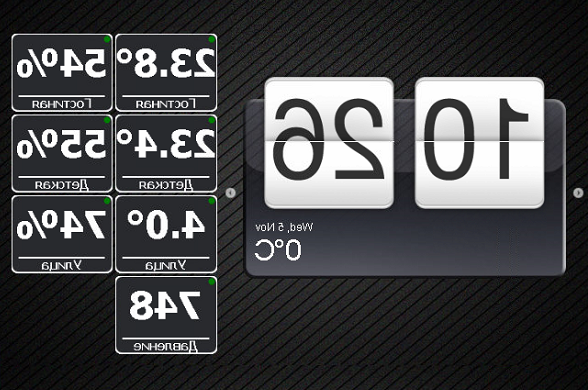
Now is dry about the necessary and process.
List of materials:
List of tools:
The process will be outlined for the Intel NUC box, for other boxes the process will be more complicated, but guess how to implement it is not a problem. So, we put the lens in the middle of the closed end of the outer part of the box. Outline the lens with a marker. Cut a hole with a stationery knife, half a millimeter smaller than a circled ring. Insert the lens into the hole. Yes, this should be done with effort, but then in the course of experiments it will not go anywhere, and you can fix it simply by applying a little superglue to the place of contact of the lens housing and box. Take the "matrix", put it on the end of the inside of the box. We put the outer part on the inner part so that we get a “pie” (from the bottom up): the inner part of the box, the “matrix”, the outer part of the box. Thus, we got a stand for selecting the correct distance between the lens and the “matrix”, because by adjusting the depth of dressing the outer part of the box to the inside, you can control the focus. It is necessary to mention that in my case the construction should be projected onto the ceiling, and, accordingly, stand vertically, so there are no surprises with the fall of the “matrix” inside the box for me, gravity can help me. Further, choosing the depth of donation we achieve an acceptable focus. At this point, note the depth of donning. The depth of the donning determine the distance between the "matrix" and the lens. After that, we remove that end of the inner part of the box, with which it enters the outer part, and in the inner spacer part we cut a seat under the “matrix”, measuring the distance found from the end of the inner part.
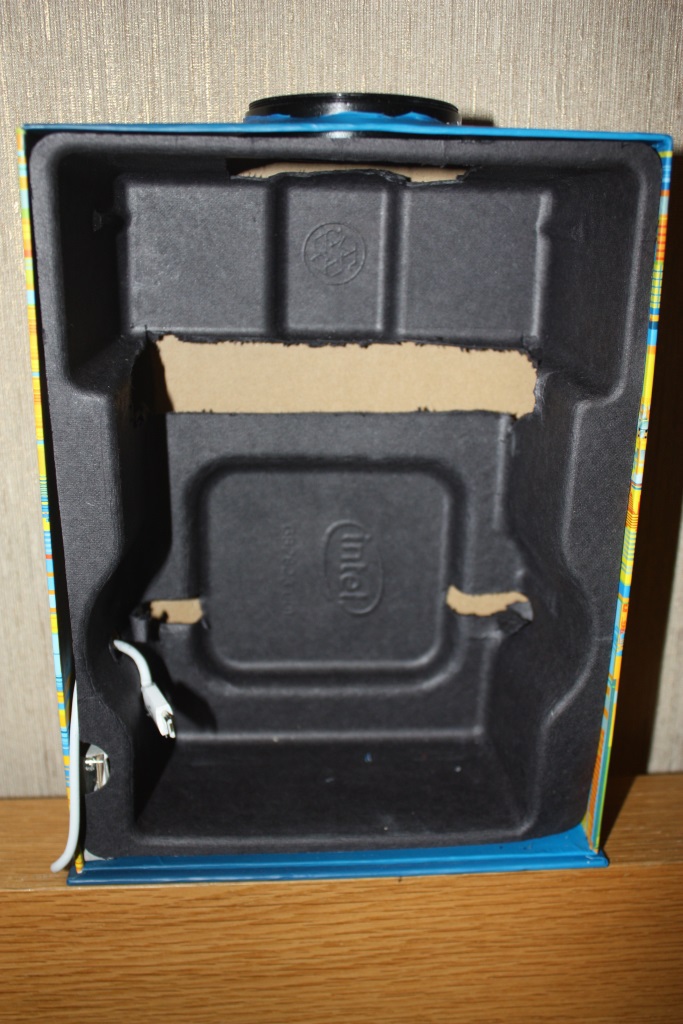
In the seat set "matrix":
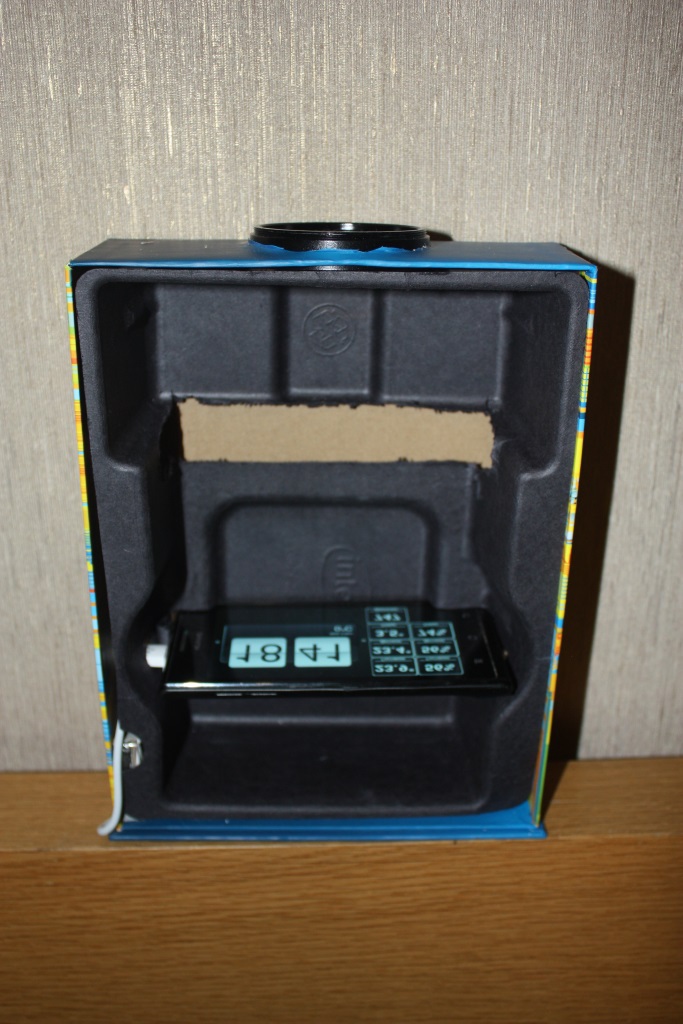
We put the outer part of the box on the inside to the full. At this moment, the required distance is formed between the “matrix” and the lens, the entire projector is ready.
Here is a photo of the projector from the end with a focus on the "matrix":

And with a focus on the end of the box:
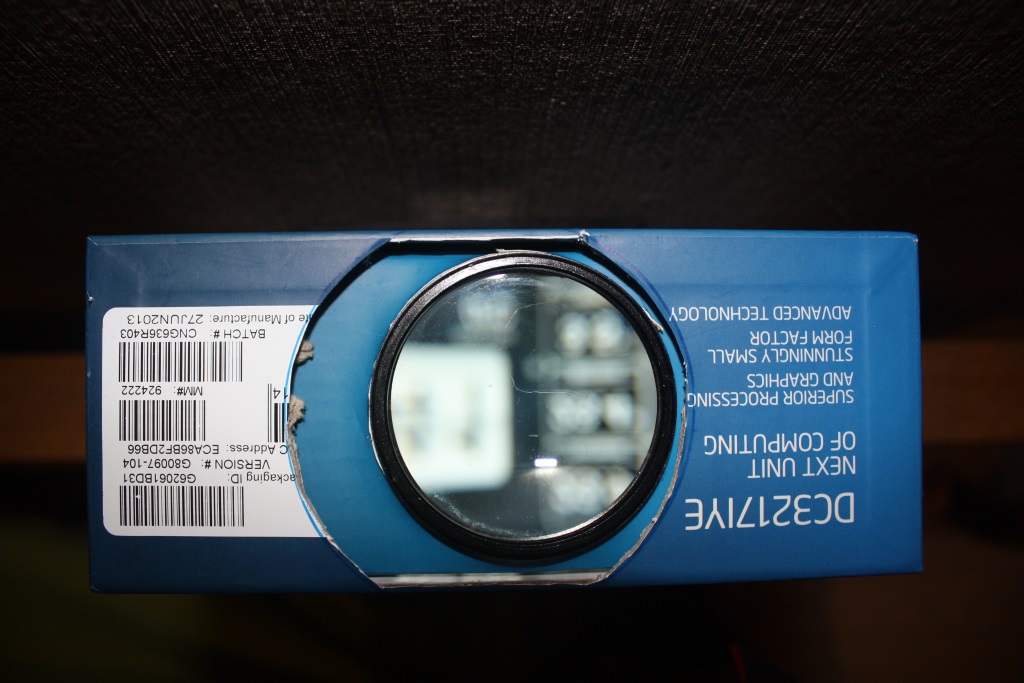
The projected image is very pale, this is understandable; nevertheless, the energy emitted by the screen in 4 "is smeared over an image of 60" in size, i.e. "Brightness" drops 225 times. So during the day it is not visible, it is visible only at night, but I did get it.
Those who read to the end of the result photo here were taken from the ceiling with an exposure of 15 seconds:
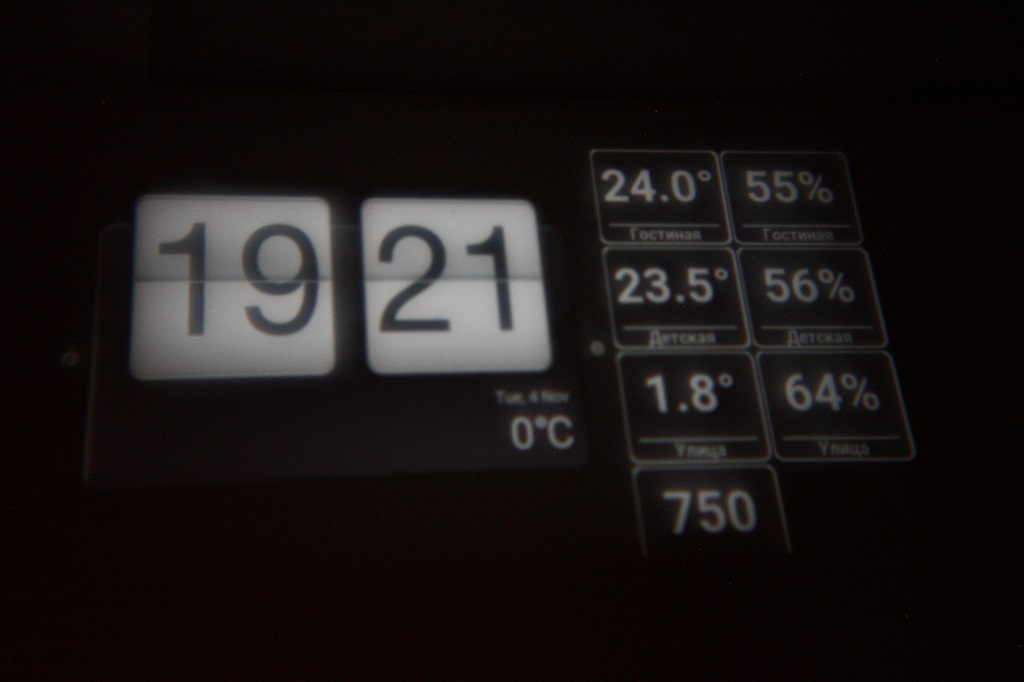
- I am myopic, so any table clock with a character size less than 20 cm is useless;
- It is inconvenient to sleep in a wristwatch, and even at night on analog analogue clocks you can’t see a damn thing;
- The phone is infinitely far (more than 1m away) from the bed, and getting up to decide whether you need another sleep is somehow not logical.
In this regard, I had a long-standing idea to buy projection clocks, which are being projected onto the ceiling, but with them, too, everything is not so simple, because, first, they need to be bought. Especially for them, you won't go to the store, but you can't buy it “at the same time” - you forget. Secondly, it is necessary that they “shine” into the ceiling constantly, because pressing a button is not that lazy, but putting the clock near the sleeping place so that it is convenient to press a button will not work. With the "constant light" the same problem - I did not find the clock shining all at once out of the box, but the collective farm itself "to hold the button forever and solder the external power supply" was not very interesting.
And it so happened that my Huawei P1 phone broke, so it stopped being a telephone, but everything else in it, in general, worked. It will not be possible to sell, but it is a pity to throw it out, and the brain inflamed by such a contradiction began to look for a place for the application of a semi-working device.
What happened next - under the cut.
The school experiment with the camera obscura seems to be imprinted forever in the mind. I always wanted to do it myself, but somehow my hands did not reach. And then there were very favorable circumstances for the creation of the device, the design is very similar, and in effect the opposite is true - the projector. Residual school-university knowledge in optics was enough to figure out that to create a masterpiece, you need, in general, only three things: the "radiating matrix", the focusing lens and the body. As the first one, the P1 could well have acted; it was not impossible to make a case out of a box of shoes, and to find an office magnifying glass for 50 rubles in a nearby stationery store did not look like a changer either. After that, it was necessary to bring some watches to P1, project them to the ceiling, and, with a fuzz, the problem with nighttime confusion was solved.
')
The raid in the stationery shop ended with the purchase of a 75mm magnifying glass, the rustling of the bins of the homeland - the capture of an Intel NUC box in the cabinet. There must be a digression about why it is the box from under the NUC. There are two reasons for this. First: it is made of very good cardboard - thick and beautiful. Second: it is designed so that the inside is inserted from the end into the outside. Such a device promised tremendous advantages in experiments with focusing - the “matrix” could be fixed on the inside of the box, the lens on the outside and quite fit to move one relative to the other, achieving focus. So the box from under the NUC supported the focusing mechanism out of the box, for shoe boxes would have had to collectively special things.
The first attempt to collect all this together, as usual, failed. It turned out that the clerical magnifying glass is an extremely long-focus thing. Therefore, in order for the image to be focused, it was necessary either to between the lens and the screen (read the ceiling, because IT had to project the image on the ceiling) was five meters, and I do not live in the Hermitage, I have 3 meters to the ceiling , or so that between the "matrix" and the lens was about 60 cm, which did not fit into my idea of the correct dimensions of the projector. Convulsive searches led to a lens in a DYI instrument called the “third hand,” like the one that was immediately sacrificed by extracting that same lens. It gave a much better result - the distance between the P1 and the lens was about 20 cm, the distance between the lens and the ceiling was about 2 m, which was suitable for mounting the device either on the table or on the headboard. However, as it turned out, this lens is of rather mediocre quality - with wild distortion and focal length, smoothly changing from the center of the lens to the edges. So it was possible to achieve that either the center of the image was in focus, or the edges, which of course did not suit me. Muti in the image was enough because of myopia, I did not want it to be generated also by the projector. Thoughts about the lens from the camera rushed convulsively in the head (they were discarded immediately, because the device, which was originally conceived as cost-free, was no longer as such due to the purchase of a clerical lens. Adding a lens to the system made it quite expensive at all) (from friends they were, and it was possible to pick up for free, but friends were far away, but the action was like here and now). And then I remembered that I have a set of macrolins for the camera, extremely useless for a photo (I played 15 minutes when I bought it and did not use it anymore) and were cheap enough (4 pieces for 10 bucks) so as not to ruin it. Bought a long time, but here it looks one to one. A lens labeled + 10x fit perfectly. It kept a distance of 20 cm between the lens and the “matrix”, under which I had cut out the seats for the “matrix” in the box and gave a very sharp image over the entire frame area.
As a result, I have a device that from the head of the bed projects the image from the phone to the ceiling.
The diagonal of the image is about 1.5 meters. It is enough to consider the numbers, having myopia of almost any degree. True, there is one snag. As with any projector, the image from the matrix is inverted with a lens. Therefore, in order for the projected image to be “correct orientation,” the matrix must show it upside down. Those. the image should be reflected either horizontally or vertically. In fact, this is a problem, because I did not find a way how to make such a focus in Android. Yes, there are separate applications, mostly all sorts of HUDs that can do it, but so that the clock ... In this place I refer to one of my previous articles , in particular, to this and this screenshots. It was possible to display not only the clock, but also climate information, which is not that useful at night, but a nice bonus. It was very easy to flip the html page, it was enough to add scaleX (-1) to the CSS style of the page and voila:

Now is dry about the necessary and process.
List of materials:
- Huawei P1 aka "matrix"
- Macro lens for camera
- Box
List of tools:
- Marker pen
- Stationery knife
- Super glue
Process
The process will be outlined for the Intel NUC box, for other boxes the process will be more complicated, but guess how to implement it is not a problem. So, we put the lens in the middle of the closed end of the outer part of the box. Outline the lens with a marker. Cut a hole with a stationery knife, half a millimeter smaller than a circled ring. Insert the lens into the hole. Yes, this should be done with effort, but then in the course of experiments it will not go anywhere, and you can fix it simply by applying a little superglue to the place of contact of the lens housing and box. Take the "matrix", put it on the end of the inside of the box. We put the outer part on the inner part so that we get a “pie” (from the bottom up): the inner part of the box, the “matrix”, the outer part of the box. Thus, we got a stand for selecting the correct distance between the lens and the “matrix”, because by adjusting the depth of dressing the outer part of the box to the inside, you can control the focus. It is necessary to mention that in my case the construction should be projected onto the ceiling, and, accordingly, stand vertically, so there are no surprises with the fall of the “matrix” inside the box for me, gravity can help me. Further, choosing the depth of donation we achieve an acceptable focus. At this point, note the depth of donning. The depth of the donning determine the distance between the "matrix" and the lens. After that, we remove that end of the inner part of the box, with which it enters the outer part, and in the inner spacer part we cut a seat under the “matrix”, measuring the distance found from the end of the inner part.
In the seat set "matrix":
We put the outer part of the box on the inside to the full. At this moment, the required distance is formed between the “matrix” and the lens, the entire projector is ready.
Here is a photo of the projector from the end with a focus on the "matrix":
And with a focus on the end of the box:
The projected image is very pale, this is understandable; nevertheless, the energy emitted by the screen in 4 "is smeared over an image of 60" in size, i.e. "Brightness" drops 225 times. So during the day it is not visible, it is visible only at night, but I did get it.
Those who read to the end of the result photo here were taken from the ceiling with an exposure of 15 seconds:
Source: https://habr.com/ru/post/242315/
All Articles